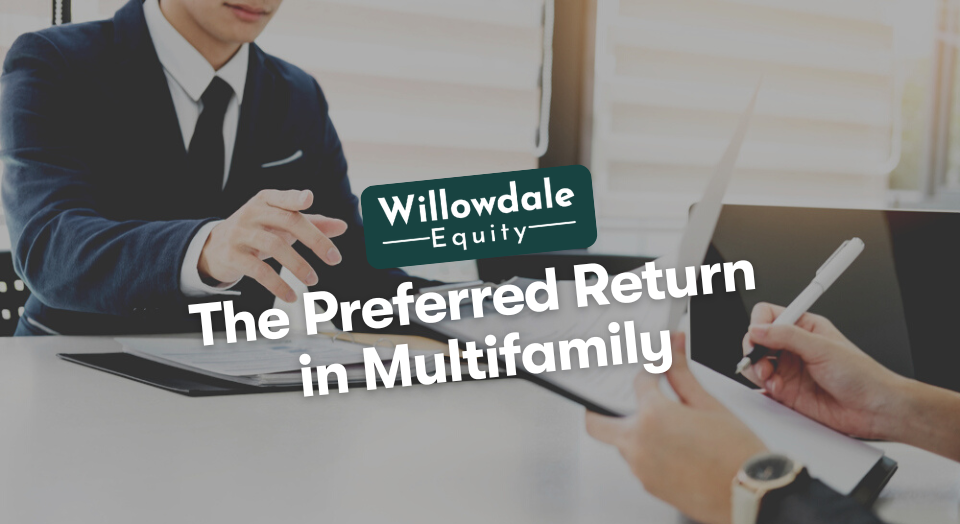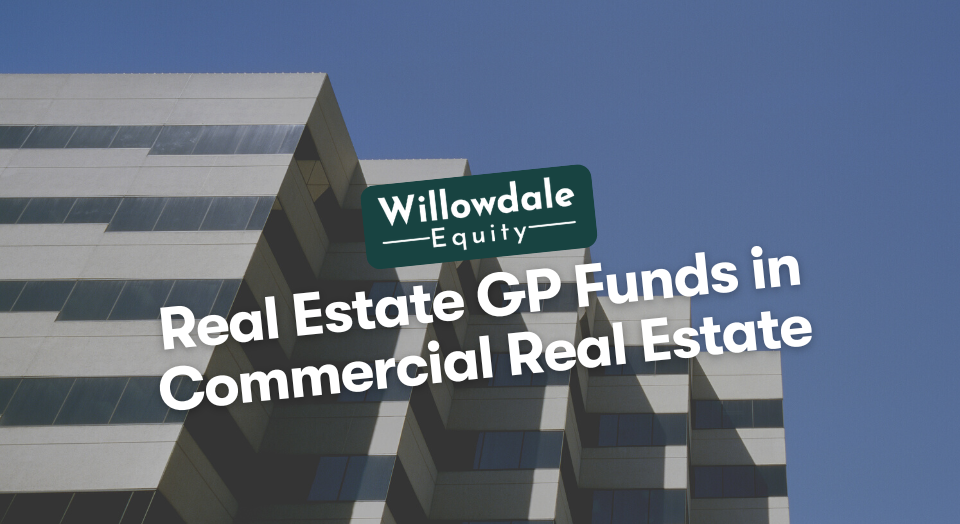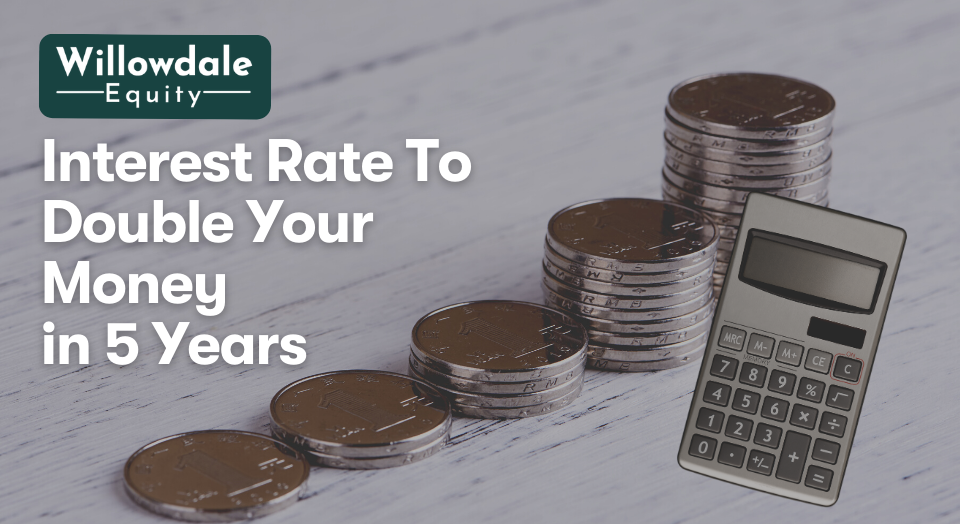
What is Preferred Return in Multifamily Real Estate Investing?
This article is part of our passive investors guide on real estate syndications, available here.
In commercial real estate, the preferred return, or “pref,” is a common feature of the waterfall framework of a real estate investment deal. So, what does a preferred return represent in property investment, and how does it work?
In this article, we’ll explain the preferred equity in private real estate, including why it aligns with the interests of multifamily investors.
Key Takeaways
-
The preferred return in multifamily property investment alludes to the precedence of investors’ receiving a specified return hurdle before the deal sponsor in the distribution of profits to investors.
-
Before the sponsor receives any distribution of funds, the investor is entitled to a prior payment based on a set return hurdle on their invested capital.
-
Preferred returns increase transparency and credibility, whether you are a passive property investor or a syndicator of properties.
What Is Preferred Return?
Before the sponsor receives any distribution of funds, the investor is entitled to a prior payment based on a set return hurdle on their invested capital. There is a division of any money left over after the payment of the preferred return between the sponsor and investor as per a pre-agreed ratio. With this arrangement, the sponsor has the incentive to maximize the property’s revenue and performance.
In other words, the return that limited partners (LPs) are to be given on their committed capital before the general partners (GPs) receive payment is alluded to as the preferred return, or simply “pref.” It is sometimes referred to as the hurdle rate and is typically expressed as an annual percentage return.
To understand this, let’s dive into the preferred return we offered to our investors here at Willowdale Equity on our acquisition of a 335-unit apartment community in San Antonio, TX.
We offered an 8% preferred return, and for this example, let’s say that the investor’s initial investment was $100,000. This indicates a target annual return of 8% on the $100,000 initial investment. This would reflect $8,000 per year, which translates into $666.67 monthly or $2,000 a quarter.
Preferred return ensures investors receive their share of profits before the deal sponsor, offering stability and incentivizing long-term alignment. It's a standard in every multifamily real estate investment that we offer to our investors.
Daniel Di Cerbo Tweet
What Is the Pref In Real Estate?
The pref is simply an abbreviation for “preferred return”. It has the same meaning as a preferred return in real estate private equity.
Preferred return, in its simplest form, relates to how earnings from a real estate investment are dispersed among investors. Preferred return signifies a legal right to profit payments.
This distribution retains its top priority until a specific threshold rate of return is reached. Any other inferior investors are given their profit allocation once the goal has been reached.
There are various ways to structure preferred returns. The following are the most common ones.
Related Read: Is a Preferred Return a Guaranteed Payment?
Preferred Equity

This arrangement relates to a place in the capital stack. It often qualifies an investor for their return on capital (principal) and a fixed-rate return before any money is released to the sponsor and other equity investors.
Common Equity — True Pref
In this structure, the investor will earn a preferred yield up to a predetermined % rate of return before any money is returned to the sponsor.
Pari Passu Preferred Return
“Pari Passu” denotes “on equal footing” in Latin. The investor and sponsor are treated equally under this structure until the predetermined return rate is reached for each party. When this mark is reached, the sponsor’s promotion will take over to distribute any remaining profits.
With preferred returns and terms such as private equity fund and preferred equity understood, it’s time to discuss what preferred return implies for multifamily investors.
Why the Preferred Return Aligns Interests amongst Multifamily Investors

The preferred return in multifamily property investment alludes to the precedence of investors’ receiving a specified return hurdle before the deal sponsor in the distribution of profits to investors. The most common application of preferred returns is in real estate investments.
The preferred returns in most multifamily real estate deal structures will fall between 5% and 8%. Let’s use John as an example to understand this better. Let’s say John received a 6% preferred return and had a 60/40 (Sponsor/Passive Investors) split on cash flow distributions after the preferred return hurdle was met for investors.
If John had invested $150,000, he would have received $9,000 in annual distributions, or 6%, before the real estate sponsor/syndicator took any distributions.
The remainder of net cash flow from the property will be divided with the sponsor, with the passive investors receiving 60% and the sponsor receiving 40%, following John’s payment of the 6% preferred return. It is a straightforward illustration of a preferred return in multifamily real estate.
Preferred returns increase transparency and credibility, whether you are a passive property investor or a syndicator of properties. Incorporating preferred returns in your investment possibilities as a syndicator demonstrates to investors that the transaction is anticipated to not only meet but even exceed the desired return. This protects investors, and the real estate syndicator shows trust in the investment proposition.
We advocate for preferred returns to foster investor confidence, responsibility, and protection, whether you’re trying to start a real estate syndication or invest passively in multifamily real estate.
If you want to truly benefit from preferred return in real estate in the form of a steady cash flow, then you need to understand capital account balance. We will be discussing that next.
The Capital Account Balance and Preferred Returns

Understanding the preferred return on a real estate investment requires a capital account. It is a separate account for each person’s money or a capital contribution to the total investment.
The investment administrator or a third-party accounting firm typically manages capital accounts, and investor reports don’t provide account information. As capital is repaid, an investor’s capital account balance drops and rises as the desired return accrues. To determine the capital account balance, the capital balance not returned is multiplied by the preferred return amortized for a particular period.
Consider an investment of $800,000 made on January 1 with a 6% preferred return. The capital account balance on June 30 of that year will be $824,000. It merely displays how much the management would pay the investor before earning a performance fee; it does not represent what the manager owes.
The preferred return is paid first in a typical real estate investment waterfall, and then the investor receives their cash back. The management will receive a disproportionate part of the earnings because they produce a higher return than the desired one.
With capital account balance understood, two more essential terms are left to explain: cumulative preferred return and accrued preferred return.
Related Read: Can an LP Deduct Losses?
What is Cumulative Preferred Return?
A cumulative preferred return enables you to carry over a trailing return from one year to the following. For instance, if your preferred return was 9%, but you only got 8% one year, your desired return would rise to 10% the following year (9% + 1% = 10%).
In a cumulative preferred return, you would start to get your total preferred return as the investment’s cash flows increase yearly. If the preferred still lacked the cash flows to make the difference, it would be owed when the asset is sold. Let’s now look at the accrued preferred return.
What is the Accrued Preferred Return?
In addition to being cumulative, the preferred return can accrue if that’s a provision specified for the deal.
In other words, if the sponsor experiences a month with abnormally high costs (during renovations) and does not release the preferred return, the proportion in deficit accrues and carries over to be paid out in addition to the dividends for the following year.
Preferred return vs IRR?
There are a few main differences between the preferred return and the IRR in real estate investing. The preferred return is a claim in priority of profits or distributions up until a specific agreed-upon percentage.
The IRR calculates the time value of profits or distributions over a given time period and is heavily influenced by the speed of returns. The main difference is that the preferred return measures a promised return on invested capital on an annual basis, while IRR calculates the time value return on invested capital throughout the entire holding period that capital was held for.
We have covered all bases regarding preferred return real estate investing. However, a few frequently asked questions (FAQs) regarding the preferred return in real estate are to be answered. That is what we will be doing next.
Frequently Asked Questions about the Preferred Return in Real Estate
If the preferred return is 8%, the person investing must get the first priority on cashflows, equating to 8% on their invested capital. Any distributions beyond 8% must fulfill the operating contract’s split or waterfall rules.
Most holders of preferred fixed-income securities invest mainly for income rather than capital gains. As a result, they are taxed on any dividends or other income they get annually.
The average yearly compounded return from a property investment they have realized over time, represented as a percentage, is shown to an investor using the IRR statistic. The first entitlement on distributions of free cash flow is the preferred return.
A pre-investment is one where an investor invests in a private investment offering to achieve a target fixed rate of return. As opposed to participating in the full upside of the investment, subject to profit splits between limited partners and general partners.
Preferred Returns in Real Estate – Conclusion
Joining a real estate syndication that offers a straightforward preferred return framework is one-way investors can protect their hard-earned investment dollars. Investors can feel secure knowing they will receive distributions before the project’s real estate sponsor realizes a profit from the transaction.
For passive investors, the preferred return is a great tool that offers a strong alignment of interest. Join the Investors Club here at Willowdale Equity to access private value-add multifamily real estate investment opportunities that provide a solid day-one preferred return.
Interested In Learning More About PASSIVE Real Estate Investing In Multifamily Properties?
Get Access to the FREE 5 Day PASSIVE Real Estate Investing Crash Course.
In this video crash course, you’ll learn everything you need to know from A to Z
about passive investing in multifamily real estate.
We’ll cover topics like earned income vs passive income, the tax advantages, why multifamily, inflation, how syndications work, and much much more!




